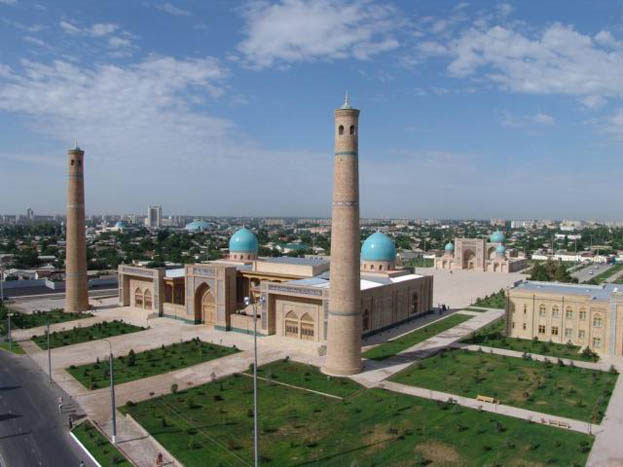|
Category
|
Hazrati Imam Complex: Barak Khan Madrasah, Kaffal Shashi mausoleum, Mui-Mubarak Madrasah, Tilla-Sheikh Mosque The complex is formed at the grave of one of the first imam of Tashkent, the famous scientist, scholar of the Qur'an and the Hadith, the poet, craftsman Abubakr Muhammad Kaffal Shashi (d. X c.) or Hazrati Imam. According to legend, his nickname Kaffal ("locksmiths") he received for making wonderful castle, the key which weighed three pounds. His grave was greatly revered. On behalf of the Sheikh the whole area in this part of the old town was named Hazrati Imam (Hast Imam). In the XVI century over the tomb of Sheikh was erected mausoleum. Despite the fact that the building of the mausoleum has repeatedly repaired, the walls of the ancient part of the mausoleum remained burnt brick and tile for a unique decor in Tashkent - Majolica XVI century from a historical inscription containing the names of the architect and calligrapher and the date of construction - 1541-1542 years. This monument is of great historical and artistic value. In the XVI century the foundation of the ensemble was Barak-khan Madrassah. There is a rich library of Oriental manuscripts. In contrast Barak-Khan Madrassa hosts acting Tilla-Sheikh mosque (XIX c.).
Also in 2007, was built the new building of the Hazrati Imam mosque by the canons of the XVI century architecture with two minarets, the gallery - "aywan" which is an excellent work of wood carvers from different schools (Kokand, Samarkand, Bukhara). For this complex from different countries were brought exotic trees, shrubs and flowers. At night, illuminated by thought-out architectural complex resembles a picture of the "1000 and One Nights." |
 The complex also includes a Madrassa Mui-Mubarak, which means "Blessed hair". According to legend, the madrasa is kept hair from the head of the Prophet Muhammad - Muslim holy relic. The building belongs to the XVI century. Later it was restored several times. In madrasas Mui-Mubarak kept the world famous the world's oldest Koran of Caliph Osman. This Quran is the primary source of the sacred books, written on the skin of a deer in the middle of VII century. Of Korans were written a total of 6. In the world have only four copies, and the most well-preserved in Uzbekistan. In England, Turkey and Egypt are the remaining 4 narratives Korans. Officially recognized by the version of how the Koran came to Uzbekistan as follows: when the Amir Temur defeated the Turkish ruler Bayazid in 1402, while returning to his homeland the way the great general passed through the Iraqi city of Basra, from which the Koran was taken and brought to Samarkand , where for a long time kept in the madrassas. In 1869 the Russian General Von Kaufman captured Samarkand and sent the Koran to the Imperial Library in St. Petersburg. In 1917 in Uzbekistan wrote a letter to the government to return the Koran to the true owner. In 1924, the Koran in a special train brought in Tashkent, where it is stored in the Museum of the History of the peoples of Uzbekistan. In 1989 at the initiative of President Islam Karimov, the Qur'an was transmitted for permanent storage Spiritual Administration of Muslims of Uzbekistan. Now he is kept in a sarcophagus, manufactured in Germany, where it is automatically maintained optimum humidity and temperature.
The complex also includes a Madrassa Mui-Mubarak, which means "Blessed hair". According to legend, the madrasa is kept hair from the head of the Prophet Muhammad - Muslim holy relic. The building belongs to the XVI century. Later it was restored several times. In madrasas Mui-Mubarak kept the world famous the world's oldest Koran of Caliph Osman. This Quran is the primary source of the sacred books, written on the skin of a deer in the middle of VII century. Of Korans were written a total of 6. In the world have only four copies, and the most well-preserved in Uzbekistan. In England, Turkey and Egypt are the remaining 4 narratives Korans. Officially recognized by the version of how the Koran came to Uzbekistan as follows: when the Amir Temur defeated the Turkish ruler Bayazid in 1402, while returning to his homeland the way the great general passed through the Iraqi city of Basra, from which the Koran was taken and brought to Samarkand , where for a long time kept in the madrassas. In 1869 the Russian General Von Kaufman captured Samarkand and sent the Koran to the Imperial Library in St. Petersburg. In 1917 in Uzbekistan wrote a letter to the government to return the Koran to the true owner. In 1924, the Koran in a special train brought in Tashkent, where it is stored in the Museum of the History of the peoples of Uzbekistan. In 1989 at the initiative of President Islam Karimov, the Qur'an was transmitted for permanent storage Spiritual Administration of Muslims of Uzbekistan. Now he is kept in a sarcophagus, manufactured in Germany, where it is automatically maintained optimum humidity and temperature. Next to the madrassas Mui-Mubarak in 2007 constructed the building of the Spiritual Administration of Muslims of Uzbekistan, where there are more than 22 thousand religious books.
Next to the madrassas Mui-Mubarak in 2007 constructed the building of the Spiritual Administration of Muslims of Uzbekistan, where there are more than 22 thousand religious books.














